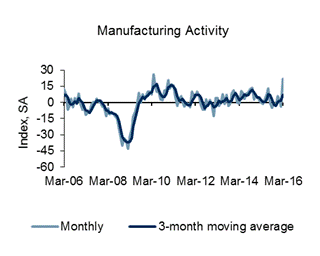
Of the three regional Federal Reserve surveys released to date, all are in expansion.
Market expectations from Bloomberg were between -3 to -2 (consensus 0). The actual survey value was +22 [note that values above zero represent expansion].
Fifth District manufacturing activity expanded in March, according to the most recent survey by the Federal Reserve Bank of Richmond. Shipments and the volume of new orders increased this month. Employment advanced at a slightly faster pace in March, while average wages grew moderately and the average workweek lengthened. Prices of raw materials and finished goods rose at a faster pace compared to last month.
Manufacturers anticipated robust business conditions during the next six months. Firms expected faster growth in shipments and in new orders in the six months ahead. Additionally, survey participants looked for increased capacity utilization and expected order backlogs to grow. Producers looked for vendor lead times to lengthen modestly.
Survey participants’ outlook for the months ahead also included faster growth in average wages and the average workweek, with a pickup in hiring during the next six months. Over the next six months, manufacturers expected faster growth in prices paid and received.
Current Activity
Overall, manufacturing activity increased markedly in March. The composite index for manufacturing climbed to a reading of 22, the highest since April 2010. The index for shipments added 38 points and the new orders index advanced 30 points, finishing at strong readings of 27 and 24, respectively. Manufacturing employment grew at a slightly faster pace this month; the employment indicator added two points to end at 11.
Backlogs flattened this month. However, the index moved up from last month’s ?14 reading to settle at 1. Capacity utilization grew at a faster pace in March, pushing the index up 22 points and ending at 17. Vendor lead time also leveled off to a reading of 0 this month. Finished goods inventories rose at a somewhat slower pace compared to a month ago. That index lost two points, ending at a reading of 18. Additionally, raw materials inventories increased at a slower pace in March. That gauge moved down to 21 from 36.









Leave A Comment